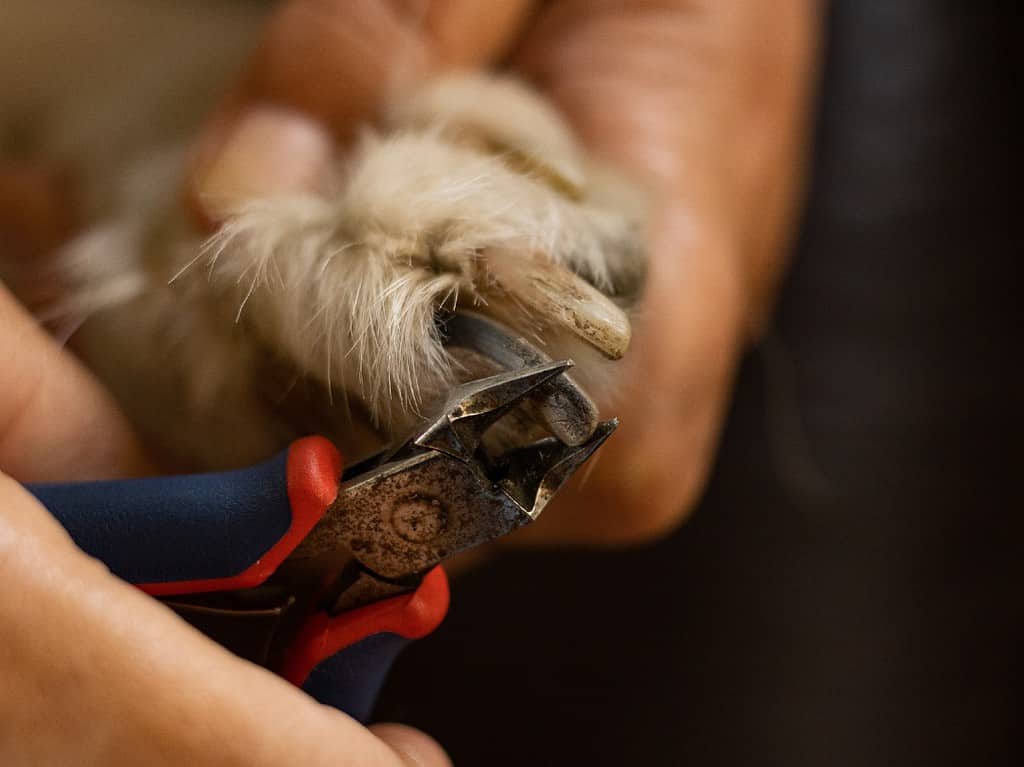If you have noticed discoloration in your dog’s nail, such as a dark or black hue, you may want to investigate what could be causing the change. Similar to humans, dogs experience changes within their bodies, which can vary from harmless ones to significant health matters that require medical attention.
This comprehensive guide examines the reasons for dog nails turning black, identifies frequent causes, and delves into potential management strategies.
As your loyal companion cannot communicate their discomfort verbally, it is crucial to understand why does a dog’s nail turn black and act quickly before its condition worsens.
Let’s dive right in!

What Color Are Healthy Dog Nails
Dog nails in good health present a transparent appearance, which may appear pale pink. The transparency of the nail is a reflection of their physical condition and well-being, as it allows for easier visibility of the quick – an area within the nail rich in sensitive nerves and blood vessels.
To maintain healthy nails, the quick should not extend beyond the end of the nail; this is evidenced by a white or clear section visible at the tip. If a dog’s nails are properly groomed and maintained, it prevents any discomfort or possible injury.
It is vital to recognize that the color of a dog’s nails may differ from one breed to the next and be determined by individualistic genetics and pigmentation. Cases have been reported where some dog nails take on slightly different shades of pink or paler hues. Nevertheless, transparency or clarity are essential indicators in assessing the well-being of any dog’s nail health, illustrating when it has been diligently nourished and adequately cared for.
The Anatomy Of A Dog’s Nail
The quick, collection of nerves and blood vessels nourishes the nail and gives it its light pink color. It is necessary to take great care when trimming a dog’s nails to avoid cutting the quick, as this may lead to irritation and bleeding.
A dog’s paw is encased by a hard protein called keratin, forming the outer shell known as the claw. This layer protects any delicate tissue that lies beneath it, and its thickness and hue may differ according to breed or individual dog characteristics.
Understanding the anatomy of a dog’s nails is crucial for proper nail care. Regular trimming of their nails is necessary for sustaining the recommended length and protecting against any discomfort or harm. Take caution when cutting a dog’s nails; watchfully not to cut into the quick.
But what should you do if you accidentally cut the quick?
Evaluate the nail injury thoroughly and decide its degree of seriousness. You may manage its treatment independently if it is mild and only a small amount of blood flows. If the animal has significant bleeding or agony, professional veterinary help should be accessed promptly.
Use a cloth or sterile gauze to apply firm and consistent pressure for minor bleeding. This will help to reduce its rate. Once the bleeding stops, After the flow of blood stops, thoroughly clean the area with an antiseptic or saltwater solution to lower the risk of any possible infection. Caution is recommended when applying substances that could create a burning sensation in your dog’s wound.
Nonetheless, if the bleeding does not stop after several minutes, contact your veterinarian for further advice.
Pay close attention to the nail for any indications of a potential infection, including redness, swelling, or discharge. If any concerning symptoms are observed, speaking with the veterinarian immediately is recommended. Depending on the situation, they may propose an antibiotic ointment or oral medication as a precaution to counteract infection.
To prevent additional unfortunate nail trim injuries, take necessary precautions when trimming your dog’s nails. Suppose you are uncomfortable with the process or have doubts about performing a manicure for your pup. In that case, we advise that you seek help from experienced professionals like groomers or veterinarians. They can provide more accurate and safer results than what can be accomplished by an inexperienced individual.
Why Does A Dog’s Nail Turn Black
Carefully consider the root cause of a dog’s blackened nail to ascertain the correct treatment route.
Trauma or Injury
Traumatic injuries or impacts to a dog’s nail can result in the nail completely changing its coloration to black; this discoloration is due to internal bleeding and accumulation of blood beneath the nail bed. Such trauma can be caused when a dog’s nails get caught or forcefully impacted, damaging delicate tissues and blood vessels.
Furthermore, injuries such as trapping a nail in a door or undergoing an intense shock to the fingernail can cause bleeding. When blood accumulates underneath the nail, it may turn dark due to the oxidation of hemoglobin over time; similar to what happens with bruises on human skin.
It can be worrying to witness the discoloration of a nail on a dog, which is usually an expected sign of injury. Although it will grow out as the nail regrows, careful observation should be done for any pain or extreme inflammation, and immediate medical assistance should be sought if needed.
Infection
Infections typically target the nail bed and surrounding tissues, causing discoloration and other symptoms. The darkened complexion often originates from a buildup of material such as dead skin cells, debris, and fungal spores within the area.
Additionally, canine nail infection may occur when the dog’s normal immune response is hindered or when they come into contact with fungal organisms. Dogs with an existing medical condition or undergoing particular treatments and weakened immune systems may be more likely to experience this issue. Furthermore, sanitation problems, trauma to the nail area, or extended exposure to moist surroundings can increase the risk of infections developing.
As the infection persists, the dog’s immune system will generate inflammatory responses in an attempt to target and subsequently eliminate the invading fungus. This response may cause a variety of nail abnormalities, such as thickening, brittleness, and discoloration. Notably, darkening of the nail (usually black) is quite common and can be attributed to fungal invasion of the underside of the nail bed, which instigates tissue destruction.
Tumors or Growths
Tumors or abnormal growths located near a dog’s nail bed can cause changes in their nails, including discoloration. Tumors and growths disrupt the naturally occurring pigment production process responsible for cell pigmentation. Consequently, a change in color to black or dark brown may be observed on the affected nail.
Tumors have been found to stem from multiple cell types, including those that create melanin – the coloring agent in skin and hair. The presence of a tumor originating from melanocytes can cause an expansion in levels of melanin at the site of the growth, resulting in discoloration or darkening manifesting as gradual or sudden changes depending on how quickly it expands.
In some circumstances, tumors may negatively impact the blood vessels and tissues that nourish the nail bed. This obstruction of blood flow or inflammation can cause discoloration in the nail, resulting in a darkening of its color. Furthermore, due to the pressure exerted by these tumors, an alteration in their appearance may arise due to disrupted growth and maintenance of said nail.
Despite the possibility of discolored nails signifying a tumor or infection, it is not necessarily an indicative marker of cancer.
Hyperpigmentation
This medical condition results from an overproduction and heightened concentration of melanin, resulting in darkened skin areas. In dogs, this can result in their nails turning black due to synthesized melanin from specialized cells called melanocytes in the nail bed. Generally, these cells will secrete healthy amounts of pigment, allowing for natural hues; however, if elevated levels are obtained, it can lead to hyperpigmentation.
There are varying explanations that can account for the occurrence of hyperpigmentation in a dog’s nails. Genetically, it has been observed that certain breeds are more apt to acquire this condition. Furthermore, particular hormonal imbalances like thyroid dysfunction and Cushing’s disease have likewise been linked to increased melanin production in dogs’ nails. Additionally, inflammation or physical damage to the nail bed may also cause an increase in melanin concentration, consequently leading to hyperpigmentation.
But here’s the thing: hyperpigmentation alone is usually not a major issue and normally poses little threat. Nonetheless, dog owners must watch for changes in their pup’s nails, which can indicate potentially serious health issues. A professional veterinary diagnosis should be considered if there is discoloration and other symptoms such as swelling, discomfort, or texture alterations of the nail material.
The Importance of Regular Dog Nail Care For Dogs
Excessively long nails on a canine can be detrimental to their quality of life, as it may lead to discomfort and mobility issues. The elimination of such complications can easily be addressed by trimming the dog’s nails. This practice will aid in preserving the animal’s welfare and well-being.
Comfort
When nails become excessively long, they may curl and puncture the paw pads of dogs, resulting in discomfort and even pain while walking. In addition, ingrown nails may occur when the nail grows into its surrounding flesh. Unchecked or neglected growth of a dog’s nails may lead to pressure on their toe joints which could cause joint pain and possible deformity over time. Proactive trimming is essential for preventing such issues ensuring that dogs stay active without foot-related problems.
Healthy Foot Structure
If nails are excessively long, it can alter the natural shape of the feet, which may lead to discrepancies in weight distribution. This could stress tendons, ligaments, and joints, provoking enduring musculoskeletal complications. Therefore, regularly trimming the nails is advisable for preserving the native alignment of the feet, which will result in a more secure footing and improved wellness overall.
Preventing Injuries
Trimming nails can help minimize the chances of breakage, splitting, or getting caught in objects. Injuries resulting from broken nails may lead to intense pain or bleeding. If left untreated, infection is possible too. As such, trimming the nails regularly will ensure a level of safety for the pet by reducing the risk associated with these issues.
Maintaining Healthy Paw Hygiene
Walking on unpaved surfaces such as grass, dirt, and pavement can accumulate debris and bacteria within their nails. This increases the risk of infection and associated bad odors stemming from this issue. Regular maintenance should therefore be undertaken to ensure that proper paw hygiene is maintained, thereby preventing any worries about potential infections or discomfort.
Preserving Household Items
The overgrowth of pet nails can detrimentally affect furniture, carpets, and floor. Dogs with extended claws have an increased probability of scratching surfaces which may lead to the need for expensive restoration. Pet owners must regularly trim their animal’s nails to guard possessions against undue deterioration.
Treatment Options For Black Nails In Dogs

Regular nail trimming is a necessary treatment option to help maintain the health of black nails in dogs. But caution must be employed, as cutting too close to the sensitive part of the nail can cause pain and bleeding.
Black nails caused by fungal infections can be treated effectively using antifungal medications. But to guarantee successful infection removal, adhere to the recommended dosage and treatment period.
Determining the cause of an underlying health disorder in a dog, such as hormonal imbalance or nutrient deficiency, is essential. To find the source of this illness, a vet will conduct a meticulous and comprehensive examination to diagnose the condition accurately and offer suitable treatment. This may entail administering hormones or altering diets to correct deficiencies.
A surgical approach may be needed in particularly extreme black nail damage or infection cases. This option would involve the extraction of the inflicted nail or dealing with a developed abscess. Surgery is usually viewed as the last viable alternative when non-surgical approaches no longer produce results or an undesirable condition has reached levels threatening the dog’s well-being.
Regardless of the treatment option, pet owners must ensure their dog’s nails are kept clean and groomed.




